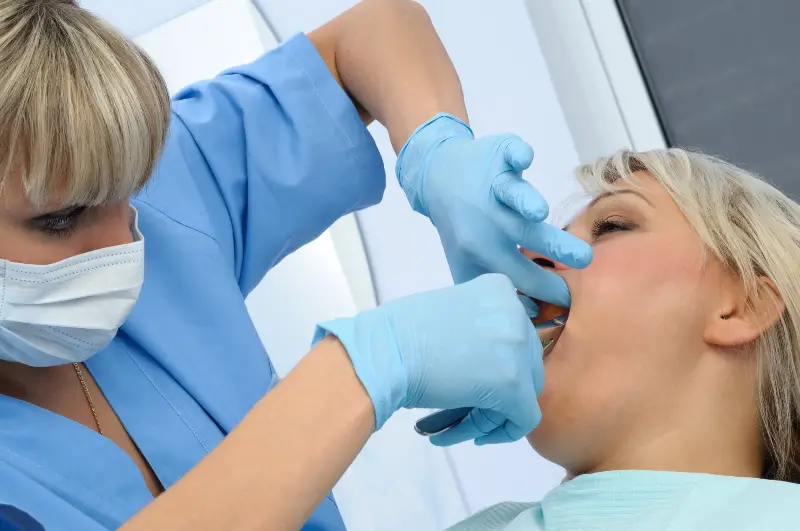A dry socket may happen after tooth removal. While it is a relatively minor complication, it can be quite painful. It occurs when the blood clot that should have formed to protect the socket doesn’t form or is dislodged. A dry socket exposes the bone and nerves in the empty socket, which can be extremely painful.
There are 11 ways you can do to avoid a dry socket.
Contents
- 1. Don’t Smoke for 48 Hours After the Procedure
- 2. Do Not Use A Straw For 48 Hours
- 3. Avoid Alcohol for 48 Hours After the Procedure
- 4. Avoid Carbonated Drinks
- 5. Eat Soft Foods For The First 7 Days After The Procedure
- 6. Practice Good Oral Hygiene
- 7. Keep the Extraction Site Clean by Rinsing Gently With Warm Salt Water
- 8. Limit Physical Activity
- 9. Get Plenty of Rest
- 10. Follow Your Dentist’s Instructions
- 11. See Your Dentist If You Have Any Concerns
- Final Thought
1. Don’t Smoke for 48 Hours After the Procedure
Smoking is a primary risk factor for developing a dry socket. The sucking motion created by smoking can dislodge the blood clot that forms in the extraction site, promoting dry socket formation. Meanwhile, smoking also delays healing and increases the risk of infection if you must smoke, do so carefully and avoid disturbing the extraction site.
2. Do Not Use A Straw For 48 Hours
Sucking on a straw, like smoking, can disrupt the blood clot that forms at the extraction site. This can result in a dry socket. Avoid using a straw for at least 48 hours after your tooth extraction.
3. Avoid Alcohol for 48 Hours After the Procedure
Alcohol consumption can also promote dry socket formation. Alcohol consumption can lead to dehydration, which can in turn make it difficult for the blood clot to form. It is best to avoid alcohol for at least 48 hours after your tooth extraction.
4. Avoid Carbonated Drinks
Carbonated beverages like soda can also cause a dry socket. The carbonation can dislodge the blood clot and delay healing. Stick to water or other non-carbonated drinks just after your procedure.
5. Eat Soft Foods For The First 7 Days After The Procedure
You’ll probably be tempted to dive right into your favorite crunchy foods after having a tooth removed. However, it’s important to give your mouth time to heal. Eating soft foods for the first 7 days will help you avoid a dry socket and other complications. Don’t eat peanuts, popcorn, chips, or other hard foods that could get stuck in the socket.
Some good soft food options include:
- mashed potatoes
- yogurt
- soup
- applesauce
- pudding
6. Practice Good Oral Hygiene
Good oral hygiene is always important, but it’s especially crucial after having a tooth extracted. Be sure to brush and floss gently around the extraction site. You can also use an alcohol-free mouthwash to keep the area clean.
7. Keep the Extraction Site Clean by Rinsing Gently With Warm Salt Water
Keeping the extraction site clean is important for preventing infection and promoting healing. Even though your mouth may initially feel sore, this is no reason for skipping a tooth brushing. Brush around the socket because if you don’t brush, bacteria quickly accumulate. However, the extraction site shouldn’t be brushed until it has healed.
A salt water rinse is a simple, effective way to clean the extraction site and promote healing. Just mix 1/2 teaspoon of salt into a cup of warm water and swish it around in your mouth for 30 seconds. Do this several times a day for the first few days after your tooth extraction.
8. Limit Physical Activity
Physical activity can increase blood flow to the extraction site and dislodge the blood clot. To reduce the risk of a dry socket, it’s important to limit physical activity for at least 24 hours after the procedure. After that, you can gradually resume your normal activities.
9. Get Plenty of Rest
Getting plenty of rest is important for healing after any surgery. When you’re well-rested, your body can better focus on healing the extraction site. Aim to get at least eight hours of sleep each night for the first few days after the procedure.
10. Follow Your Dentist’s Instructions
Your dentist will give you specific instructions on how to care for your extraction site. Be sure to follow these instructions carefully to reduce your risk of developing a dry socket.
11. See Your Dentist If You Have Any Concerns
If you experience a dry socket or any other difficulties after having a tooth pulled, make an appointment with your dentist. They can provide pain relief and facilitate recovery by prescribing medication.
Final Thought
With proper care, most people heal from a tooth extraction without any problems. However, it’s still important to see your dentist for follow-up appointments to make sure everything is progressing as it should.
